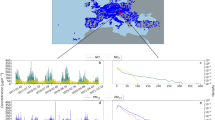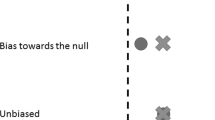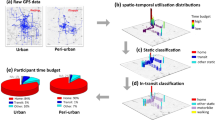Abstract
The degree of certainty in epidemiological studies is probably limited more by estimates of exposure than by any other component. We present a methodology for computing daily pollutant concentration fields that reduces exposure uncertainty and bias by taking account of spatial variation in air quality. This approach, using elliptical influence functions, involves the optimum blending of observations from a monitoring network with gridded pollution fields predicted by the complex air quality model TAPM. Such fields allow more information to be incorporated in the exposure fields used in epidemiological studies, rather than having to assume that ambient exposure is the same across a whole city and/or that individuals remain at the one location for the duration of a study.
This is a preview of subscription content, access via your institution
Access options
Subscribe to this journal
Receive 6 print issues and online access
$259.00 per year
only $43.17 per issue
Buy this article
- Purchase on Springer Link
- Instant access to full article PDF
Prices may be subject to local taxes which are calculated during checkout








Similar content being viewed by others
References
Cressman G.F. An operational objective analysis system. Mon Weather Rev 1959: 87: 367–374.
Daley R. Atmospheric Data Analysis. Cambridge Atmospheric and Space Science Series. Cambridge University Press, ISBN 0-521-38215-7. 1991, 457pp.
Dockery D.W., et al. An association between air pollution and mortality in six US cities. N Engl J Med 1993: 329 (24): 1753–1759.
Evensen G. The Ensemble Kalman Filter: theoretical formulation and practical implementation. Ocean Dynam 2003: 53: 343–367.
Floisand I., et al. Calculations of personal exposure to particulate matter in urban areas. Preprints: 28th NATO/CCMS International Technical Meeting on Air Pollution Modelling and its Application, Leipzig, Germany, May 2006. pp. 174–181.
Gandin L.S. Objective analysis of meteorological field. Gidrometeorologicheskoe Izdate'stvo. Leningrad, USSR, 1963, 286pp.
Gauthier P., Charette C., Fillion L., Koclas P., and Laroche S. Implementation of a 3d variational data assimilation system at the Canadian Meteorological Centre. Part I: The global analysis. Atmos Ocean 1999: 37: 103–156.
Georgopoulos P.G., et al. A source-to-dose assessment of population exposures to fine PM and ozone in Philadelphia, PA, during a summer 1999 episode. J Expos Anal Environ Epidemiol 2005: 15 (5): 439–457.
Gulliver J., and Briggs D.J. Time-space modeling of journey-time exposure to traffic-related air pollution using GIS. Environ Res 2005: 97 (1): 10–25.
Hurley P.J., Manins P.C., Lee S.H., Boyle R., Ng Y.L., and Dewundege P. Year-long, high-resolution, urban airshed modelling: verification of TAPM predictions of smog and particles in Melbourne, Australia. Atmos Environ 2003: 37: 1899–1910.
Hurley P.J., Physick W.L., and Luhar A.K. TAPM: a practical approach to prognostic meteorological and air pollution modelling. Environ Model Software 2005: 20: 737–752.
Morgan G., Corbett S., and Wlodarczyk J. Air pollution and hospital admissions in Sydney, Australia, 1990 to 1994. Am J Public Health 1998: 88 (12): 1761–1766.
Physick W.L. Photochemical smog studies in Australian cities. In: Power H., Moussiopoulos N. (Eds.). Urban Air Pollution, Vol. 2. Computational Mechanics Publications, Southampton, Boston, 1996, pp. 141–184.
Schwarz J. Air pollution and hospital admissions for the elderly in Birmingham, Alabama. Am J Epidemiol 1994: 139: 589–598.
Seaman N.L., Stauffer D.R., and Lario-Gibbs A.M. A multi-scale four dimensional data assimilation system applied in the San Joaquin valley during SARMAP. Part I: modeling design and basic performance. J Appl Meteorol 1995: 34: 1739–1761.
Sun L., Zidek J.V., Le N.D., and Ozkaynak H. Interpolating Vancouver's daily ambient PM10 field. Environmetrics 2000: 11 (6): 651–663.
Zidek J., Sun L., Le N., and Ozkaynak H. Contending with space-time interaction in the spatial prediction of pollution: Vancouver's hourly ambient PM10 field. Environmetrics 2002: 13 (5–6): 595–613.
Acknowledgements
We are appreciative of the provision of emissions inventories and monitoring data by EPA Victoria and EPA Queensland, and to CSIRO's Preventative Health Flagship for funding this work. We thank Mark Hibberd for insightful advice.
Author information
Authors and Affiliations
Corresponding author
Rights and permissions
About this article
Cite this article
Physick, W., Cope, M., Lee, S. et al. An approach for estimating exposure to ambient concentrations. J Expo Sci Environ Epidemiol 17, 76–83 (2007). https://doi.org/10.1038/sj.jes.7500523
Received:
Accepted:
Published:
Issue Date:
DOI: https://doi.org/10.1038/sj.jes.7500523
Keywords
This article is cited by
-
A Bayesian hierarchical approach to account for left-censored and missing radiation doses prone to classical measurement error when analyzing lung cancer mortality due to γ-ray exposure in the French cohort of uranium miners
Radiation and Environmental Biophysics (2020)
-
Application of a chemical transport model and optimized data assimilation methods to improve air quality assessment
Air Quality, Atmosphere & Health (2014)



